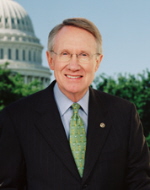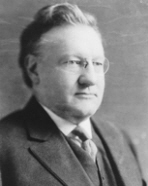Harry Reid Could Become Just Fifth Senate Party Floor Leader to Lose at the Ballot Box
Death more common than defeat in ending the reign of Senate’s majority and minority leaders; over 86 percent have won reelection since 1920

This has not been the case for Nevada Senator and Democratic Majority Leader Harry Reid during his bid for a fifth term in 2010.
Nevada GOP nominee Sharon Angle and Reid, who became the Democratic floor leader in 2005, have been within five points of one another during the last two-dozen non-partisan horserace polls conducted since late July.
For the Democrats, this is a replay of sorts of 2004, when Republican John Thune defeated Tom Daschle by less than 5,000 votes. In that election, a majority of South Dakotans determined it was more important to send a freshman Republican to D.C. than to retain Daschle, who had been the Democratic floor leader for a decade.
Despite the Daschle loss, the defeat of a Senate floor leader at the ballot box is still exceedingly rare.
A Smart Politics analysis finds that party floor leaders have won more than 86 percent of general election contests while holding that title: 25 wins and just 4 losses.
Majority and minority party leaders have also averaged 61.8 percent of the vote and enjoyed an average margin of victory of 24.8 points across these 29 elections.
Since 1920, there have been 11 Democratic and 16 Republican floor leaders in the U.S. Senate. (Note the data in this analysis includes Massachusetts Republican Henry Cabot Lodge, who was the GOP’s party conference chairman and served as an unofficial party leader when the Democrats elected their first leader, Oscar Underwood in 1920).
Only four party leaders have been defeated at the ballot box – three Democrats and one Republican.

Democratic Majority Leaders Scott Lucas of Illinois and Ernest McFarland of Arizona were defeated in back-to-back election cycles. Lucas lost by 8.1 points to future GOP Minority Leader Everett Dirksen in 1950 while McFarland was narrowly defeated by future Republican presidential nominee Barry Goldwater in 1952 (by 2.6 points).
It would take another 52 years before another Senate floor leader would be toppled at the polls – Daschle, who lost by 4,508 votes to John Thune in 2004.
But most reelection bids by such Senate leaders have not been so close.
Senate majority and minority leaders have won their reelection bids by more than 15 points in 18 out of 29 contests over the past 90 years.
Overall, party floor leaders have averaged 61.8 percent of the vote across these 29 reelection contests, with challengers receiving just 37.1 percent, or a +24.8-point differential.
And just how unusual is it for Senate majority and minority leaders to see their leadership reign end through an election defeat?
Unusual enough that more Senate floor leaders have exited their position through death than defeat at the ballot box.
Of the 25 former majority and minority leaders, nearly one-quarter (six) died while still holding their post: Republicans Henry Cabot Lodge (MA), Charles McNary (OR), Kenneth Wherry (NE), Robert Taft (OH), and Everett Dirksen (IL) and Democrat Joseph Robinson (AR).
An additional 11 leaders either did not seek another term or retired from the U.S. Senate before a new session, including four who became presidential or vice-presidential nominees: Republicans Charles Curtis (KS, to become Vice President under Herbert Hoover), Wallace White, Jr. (ME), William Knowland (CA), Hugh Scott (PA), Howard Baker (TN), and Bob Dole (KS, to run for President), and Democrats Alben Barkley (KY, to become Vice President under Harry Truman), Lyndon Johnson (TX, to become Vice President under John Kennedy), Mike Mansfield (MT), and George Mitchell (ME).
Another four party floor leaders stepped down from their position, without immediately retiring from the Senate: Democrat Oscar Underwood (AL, due to illness), Republican Styles Bridges (NH, to become Appropriations Committee chair and president pro tempore), Democrat Robert Byrd (WV, to become Appropriations Committee chair and president pro tempore), and Republican Trent Lott (MS, under pressure from his caucus).
But the trouble Harry Reid finds himself in today is not wholly out of step with the times.
As Congress’ approval rating has been particularly low in recent years, there has been a trend of its majority and minority leaders in jeopardy.
In addition to Daschle’s 2004 defeat, Republican Minority Leader Mitch McConnell of Kentucky escaped with a 5.9-point victory over Democrat Bruce Lunsford in 2008 – the fifth narrowest victory by a majority or minority leader during the past 90 years.
All signs from the Silver State indicate the Reid-Angle matchup will provide even more drama a week from Tuesday.
Electoral Fate of Senate Majority and Minority Leaders, 1920-Present
|
Year
|
Party leader
|
Party
|
State
|
%
|
Opp.
|
MoV
|
|
1920
|
Oscar Underwood
|
Dem
|
AL
|
66.1
|
33.1
|
33.0
|
|
1922
|
Henry Cabot Lodge
|
GOP
|
MA
|
47.6
|
46.7
|
0.9
|
|
1924
|
Joseph Robinson
|
Dem
|
AR
|
73.5
|
26.5
|
47.0
|
|
1926
|
Charles Curtis
|
GOP
|
KS
|
63.6
|
34.7
|
28.9
|
|
1930
|
Joseph Robinson
|
Dem
|
AR
|
100.0
|
0.0
|
100.0
|
|
1932
|
James Watson
|
GOP
|
IN
|
43.2
|
56.8
|
-13.6
|
|
1936
|
Joseph Robinson
|
Dem
|
AR
|
84.1
|
15.1
|
69.0
|
|
1936
|
Charles McNary
|
GOP
|
OR
|
49.7
|
48.3
|
1.4
|
|
1938
|
Alben Barkley
|
Dem
|
KY
|
62.0
|
38.0
|
24.0
|
|
1942
|
Charles McNary
|
GOP
|
OR
|
77.1
|
22.9
|
54.2
|
|
1944
|
Alben Barkley
|
Dem
|
KY
|
54.8
|
44.9
|
9.9
|
|
1950
|
Scott Lucas
|
Dem
|
IL
|
45.8
|
53.9
|
-8.1
|
|
1952
|
Ernest McFarland
|
Dem
|
AZ
|
48.7
|
51.3
|
-2.6
|
|
1954
|
Lyndon Johnson
|
Dem
|
TX
|
84.6
|
14.9
|
69.7
|
|
1960
|
Lyndon Johnson
|
Dem
|
TX
|
58.0
|
41.1
|
16.9
|
|
1962
|
Everett Dirksen
|
GOP
|
IL
|
52.9
|
47.1
|
5.8
|
|
1964
|
Mike Mansfield
|
Dem
|
MT
|
64.5
|
35.5
|
29.0
|
|
1968
|
Everett Dirksen
|
GOP
|
IL
|
53.0
|
46.6
|
6.4
|
|
1970
|
Mike Mansfield
|
Dem
|
MT
|
60.5
|
39.5
|
21.0
|
|
1970
|
Hugh Scott
|
GOP
|
PA
|
51.4
|
45.4
|
6.0
|
|
1978
|
Howard Baker
|
GOP
|
TN
|
55.5
|
40.3
|
15.2
|
|
1982
|
Robert Byrd
|
Dem
|
WV
|
68.5
|
30.8
|
37.7
|
|
1986
|
Bob Dole
|
GOP
|
KS
|
70.0
|
30.0
|
40.0
|
|
1988
|
Robert Byrd
|
Dem
|
WV
|
64.8
|
35.2
|
29.6
|
|
1992
|
Bob Dole
|
GOP
|
KS
|
62.7
|
31.0
|
31.7
|
|
1998
|
Tom Daschle
|
Dem
|
SD
|
62.1
|
36.4
|
25.7
|
|
2000
|
Trent Lott
|
GOP
|
MS
|
65.9
|
31.6
|
34.3
|
|
2004
|
Tom Daschle
|
Dem
|
SD
|
49.4
|
50.6
|
-1.2
|
|
2008
|
Mitch McConnell
|
GOP
|
KY
|
53.0
|
47.0
|
5.9
|
|
Total
|
|
|
61.8
|
37.1
|
24.8
|
Note: Seven U.S. Senators never went up for reelection while holding their party floor leader title: Republicans Wallace White (ME), Kenneth Wherry (NE), Styles Bridges (NH), Robert Taft (OH), William Knowland (CA), and Bill Frist (TN) and Democrat George Mitchell (ME). Election data compiled from the Office of the Clerk of the U.S. House of Representatives by Smart Politics.
Follow Smart Politics on Twitter.

“…did not seek another term or ‘retired’…” A TEXTBOOK case of redundancy, indeed! (e.g. William Knowland RETIRED from the Senate after the 1958 elections, figuring that, being a state governor, or at least not being an incumbent US senator, was a more favourable path to the presidency; Lyndon Johnson RESIGNED from the Senate in order to become vice president, more than a fortnight after starting his new term in the body in early 1961).